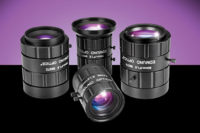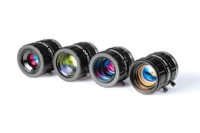Flexible Imaging Lens Designs

This high-resolution 5-megapixel fixed focal length lens comes in two focal lengths and features multiple versions to optimize for different working distance ranges. Source: Edmund Optics
The needs of the imaging world are continuously evolving, requiring lenses to be lower cost, higher resolution and more versatile than ever. The increasing demands necessitate lens manufacturers and designers to develop more adaptable, more efficient and more economical lenses.
Versatility
Before a lens is produced or designed, the versatility and manufacturability of the lens must be considered and incorporated into the design process. Clever features and proprietary techniques can transform a single-use design into a multipurpose solution. Such adaptability increases volume production, lowers costs for end-users and OEMs, and makes projects more economically viable when considering long-term forecasts.Considerations
The biggest downside to trying to incorporate significant forethought and intelligent design up front is that it can lead to lengthy and complex design process and may result in more variables, which can go wrong in the initial prototyping phase.But the final result tells the story: production lenses that are advanced pieces of technology, superior quality and more suited to the ever changing needs of the world from machine vision integrators and systems OEMs to corporate and college labs.
For instance, when designing a lens, it is critical to first define its overall scope. Should the new high-resolution fixed focal length lens design maximize a ⅔-inch, 5-megapixel sensor with 3.45 micron pixels? When the answer is yes, this quickly leads to additional questions, such as at what working distance and magnification is needed, and is performance at the edge of the field equally as critical as performance at the center?
Many of the commercially available 5-megapixel lenses in production have focused on the first question without considering the importance of the second set of questions. Many of the companies have 5-megapixel lenses that will maximize the sensor, but only in the center of the image, and only over a very small working distance range that cannot be changed, greatly reducing the usability and predictability of the lens.
However, lenses with true 5-megapixel performance across the entire image field and over a broad range of working distance options are available that offer performance advantages to customers. These advantages include the ability to resolve high-resolution with strong contrast at any point of the image and knowing that this can be predictably achieved anywhere from very close up, out to infinity. This can be achieved using a clever design method, which, while adding a small amount of manufacturing complexity, increases the useable range of high-resolution lenses.
By substituting in subtly different front or rear optical elements into these multi-element designs, a manufacturer can shift the optimized region for this type of lens. Instead of buying a lens that has been optimized at one working distance and provides inferior performance everywhere else, this design technique yields lenses with multiple optimized conjugates (working distance ranges) versions for the manufacturer to choose from.
Typically, two or three versions will cover the full range of options, from 200 millimeters to infinity, allowing one to select the most suitable lens for the current application.

A compact micro video lens must forego many of the features in a traditional fixed focal length lens, such as a focus ring, an adjustable iris and filter threading. Source: Edmund Optics
Adaptability
While inventive approaches in the optical design can lead to great benefits, sometimes all that is necessary to increase the functionality of a lens design is to modify the metal that surrounds the lenses. For instance, a compact micro video lens must forego many of the features in a traditional fixed focal length lens such as a focus ring, an adjustable iris and filter threading. However, this does not mean that many of the same benefits cannot be achieved with just a bit of effort on the part of the lens manufacturer.Focusablity is the most straightforward to achieve and is accomplished simply by putting an extended amount of threading onto the lens. This allows the operator to screw the lens in and out to achieve best focus. Locking also can still be achieved with locking nuts designed for use with this type of lens.
An iris, although not cost feasible in most micro video lenses, allows the operator to vary the f-stop of the lens being used, resulting in increased control over the balance between resolution, light collection and depth of field. To mimic this feature, the aperture at the stop of the lens can be mechanically designed to have different sizes substituted on the production floor. This allows an 8-millimeter lens designed to have a minimum aperture of f/2.5 to quickly have other versions available, such as f/4, f/8 or whichever is needed for an application, without a new design process.
Such adaptability provides options and significant value to customers. A good lens manufacturer or system integrator can work directly with the customer to determine the specific f-stop requirements of their system, and can quickly deliver an off-the-shelf lens or a slightly modified custom lens, tailor-made to the customer’s needs.

These high performance imaging lenses offer high-resolution and are designed specifically for line scan and large area scan cameras. Source: Edmund Optics
Methods
The most complex feat is trying to gain some of the benefits of filter threading, particularly the ability to have an IR-cut filter. Within a micro video lens this is predominantly achieved in one of two methods. The first method involves leaving all of the metal components the same and coating one of the lens surfaces with an IR-cut coating.The downside to this route is that filter coatings can be highly angle-dependent, and putting one on the surface of a lens, particularly one that still requires high visible transmission, can be costly and problematic, in addition to requiring a new production run of at least the newly coated lens.
The second option is to insert a thin and flat IR-cut filter into the lens path allowing for higher levels of transmission and light control. However, this cannot always be accommodated with the existing metal design and may require a new housing to be ordered. Both methods are used by lens fabricators, and show that a simple lens design does not have to decrease flexibility.
The last example of a clever optical design technique is the most complex, but also the most rewarding to customers. The technique requires a dynamic, robust optical design coupled with mechanical modifications resulting in a design capable of adapting to many magnifications while maintaining high-resolution and fast f-stops.
A typical design solution for this fixed magnification lens exists which allows for one set of optical elements that, with a small number of changes, can have full performance functionality from 0.33X to 3X. With only a minimal number of internal mechanical part changes, the spacing can be altered, providing the 0.33X to 1X range, and by allowing the entire assembly to be flipped or rotated 180 degrees, the lens achieves the 1X to 3X range.
This allows rapid customization of magnification for any standard magnifications offered. For example, if the standard part has a 2X option, it can be customized into a 2.4X part with just a few internal part changes at the factory during assembly.
Art and Science
Lens design is as much an art as it is a science; it requires a vast technical know-how and also needs creative imagination and the courage to try something unconventional.Designing lenses today is more difficult than ever, thanks to increasing camera sensor resolutions and decreasing pixel sizes, coupled with the pressure to lower costs and to fully satisfy customers’ needs and expectations.
Through clever engineering, adaptable manufacturing and significant forethought upfront, however, superior lenses can be produced. Whether the end result is an off-the-shelf solution that fully meets the customer’s needs, or a lens that is quickly and cost-effectively modified for optimum performance, the customer’s application, budget and time to market are all beneficiaries. V&S
Tech Tips
Looking for a reprint of this article?
From high-res PDFs to custom plaques, order your copy today!








